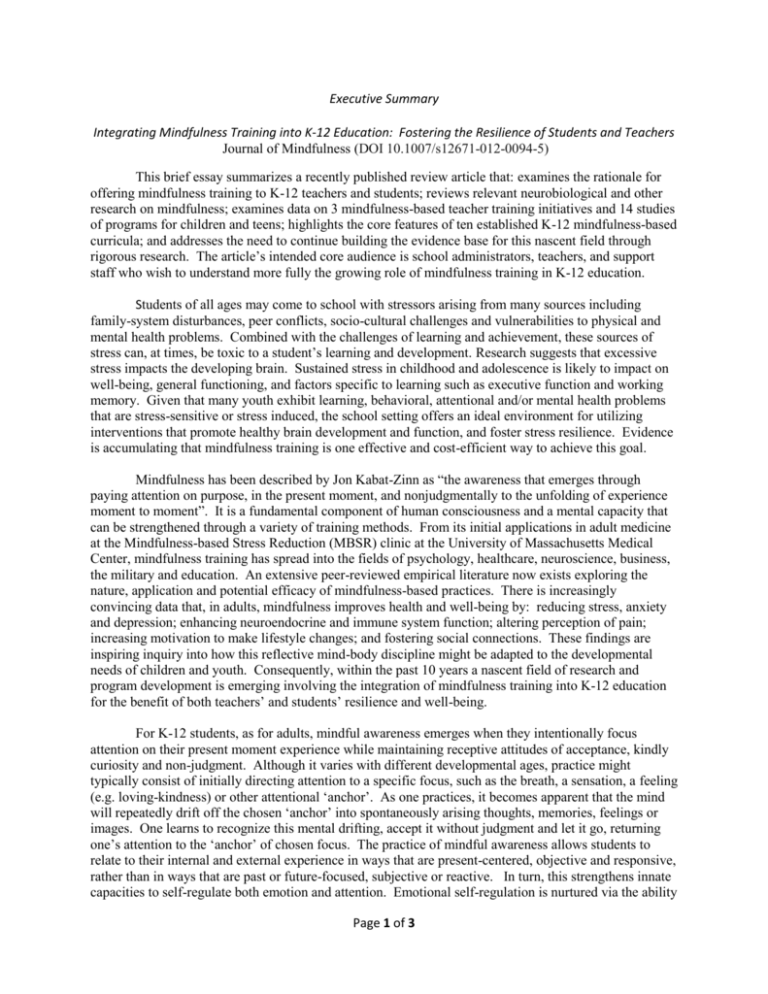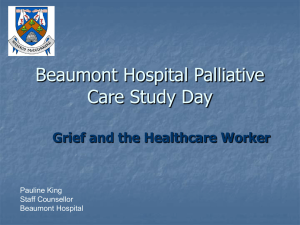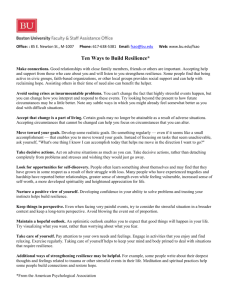Executive Summary Integrating Mindfulness Training into K
advertisement

Executive Summary Integrating Mindfulness Training into K-12 Education: Fostering the Resilience of Students and Teachers Journal of Mindfulness (DOI 10.1007/s12671-012-0094-5) This brief essay summarizes a recently published review article that: examines the rationale for offering mindfulness training to K-12 teachers and students; reviews relevant neurobiological and other research on mindfulness; examines data on 3 mindfulness-based teacher training initiatives and 14 studies of programs for children and teens; highlights the core features of ten established K-12 mindfulness-based curricula; and addresses the need to continue building the evidence base for this nascent field through rigorous research. The article’s intended core audience is school administrators, teachers, and support staff who wish to understand more fully the growing role of mindfulness training in K-12 education. Students of all ages may come to school with stressors arising from many sources including family-system disturbances, peer conflicts, socio-cultural challenges and vulnerabilities to physical and mental health problems. Combined with the challenges of learning and achievement, these sources of stress can, at times, be toxic to a student’s learning and development. Research suggests that excessive stress impacts the developing brain. Sustained stress in childhood and adolescence is likely to impact on well-being, general functioning, and factors specific to learning such as executive function and working memory. Given that many youth exhibit learning, behavioral, attentional and/or mental health problems that are stress-sensitive or stress induced, the school setting offers an ideal environment for utilizing interventions that promote healthy brain development and function, and foster stress resilience. Evidence is accumulating that mindfulness training is one effective and cost-efficient way to achieve this goal. Mindfulness has been described by Jon Kabat-Zinn as “the awareness that emerges through paying attention on purpose, in the present moment, and nonjudgmentally to the unfolding of experience moment to moment”. It is a fundamental component of human consciousness and a mental capacity that can be strengthened through a variety of training methods. From its initial applications in adult medicine at the Mindfulness-based Stress Reduction (MBSR) clinic at the University of Massachusetts Medical Center, mindfulness training has spread into the fields of psychology, healthcare, neuroscience, business, the military and education. An extensive peer-reviewed empirical literature now exists exploring the nature, application and potential efficacy of mindfulness-based practices. There is increasingly convincing data that, in adults, mindfulness improves health and well-being by: reducing stress, anxiety and depression; enhancing neuroendocrine and immune system function; altering perception of pain; increasing motivation to make lifestyle changes; and fostering social connections. These findings are inspiring inquiry into how this reflective mind-body discipline might be adapted to the developmental needs of children and youth. Consequently, within the past 10 years a nascent field of research and program development is emerging involving the integration of mindfulness training into K-12 education for the benefit of both teachers’ and students’ resilience and well-being. For K-12 students, as for adults, mindful awareness emerges when they intentionally focus attention on their present moment experience while maintaining receptive attitudes of acceptance, kindly curiosity and non-judgment. Although it varies with different developmental ages, practice might typically consist of initially directing attention to a specific focus, such as the breath, a sensation, a feeling (e.g. loving-kindness) or other attentional ‘anchor’. As one practices, it becomes apparent that the mind will repeatedly drift off the chosen ‘anchor’ into spontaneously arising thoughts, memories, feelings or images. One learns to recognize this mental drifting, accept it without judgment and let it go, returning one’s attention to the ‘anchor’ of chosen focus. The practice of mindful awareness allows students to relate to their internal and external experience in ways that are present-centered, objective and responsive, rather than in ways that are past or future-focused, subjective or reactive. In turn, this strengthens innate capacities to self-regulate both emotion and attention. Emotional self-regulation is nurtured via the ability Page 1 of 3 to be non-reactively aware of emotions and to modulate the intensity and duration of emotion-laden arousal. The skill of self-regulating attention is gradually enhanced through repeated and intentional focusing, sustaining and shifting of attention. In short, the research to date points to the possibility that through this experiential practice students learn an attitude - a way of being - in their day to day living that broadens the skill sets of attention, balance and compassion and reduces the universal human tendency under stress to become reactive and impulsive. Innovative programs in the U.S. and elsewhere are now offering mindfulness training to K-12 students, their teachers and, in some cases, parents as well. A few examples include: Inner Resilience Program (USA) (http://www.innerresilience-tidescenter.org/ ); South Burlington School District’s Wellness and Resilience Program (USA) (http://sbsd.schoolfusion.us/modules/cms/pages.phtml?pageid=195404&SID); Inner Kids Program (USA)(www.susankaisergreenland.com); Mindful Schools (USA)(www.mindfulschools.org); Learning to Breathe (USA) (www.learning2breathe.org); Mindfulness in Schools Project (U.K.) (www.mindfulnessinschools.org); Still Quiet Place (USA) (www.stillquietplace.com); Stressed Teens (USA) (www.stressedteens.com); and Wellness Works in Schools (USA) (www.wellnessworksinschools.com). These initiatives utilize two main methods for bringing mindful practices to students. The first is by having individuals who are trained mindfulness teachers guide the mindful practices either in the classroom or in after-school programs. The second is to train classroom teachers to guide students. K-12 teachers, like their students, need and deserve supports to flourish, professionally and personally. In an era of high stakes testing, tightening budget constraints and other increased pressures, K-12 educators all too often encounter a cascade of stressors and warrant interventions that support their resilience and social-emotional competencies. Such interventions can lower the risk of professional languishing and/or burnout due to emotional exhaustion. An extensive body of medical, neurological and psycho-social research supports the contention that mindfulness training holds promise for being one such intervention for teachers. Three examples of such teacher training initiatives are: Mindfulness-Based Wellness Education (MBWE) at the Ontario Institute of Studies in Education of the University of Toronto; Cultivating Awareness and Resilience in Education (CARE) (www.garrisoninstitute.org); and Stress Management and Relaxation Techniques (SMART) in Education (http://smart-in-education.org/). Teachers who are supported by being offered the opportunity to learn this shift in attitude towards a more mindful way of moving through their day, often begin inquiring how they might teach these same practices to their students. In this way classroom teachers first learn to embody a more mindful way of being for their own sake; in turn, this allows them to authentically embody the teachings they wish to impart about being aware and mindful to their students. If successful, this would be one excellent way to foster within a school community the skills of attention, balance, compassion and resilience; i.e. nourishing teachers’ optimal brain function and well-being so that they may, in turn, more effectively nourish the same in their students. Current research in this field points to benefits for children and adolescents similar to the benefits for adults. School-based mindfulness training appears to offer a means for students to cultivate attentional skills as well as an array of other aptitudes that may enhance their capacity to cope with their psychosocial as well as academic challenges. Potential benefits include: fostering pro-social behavior via strengthening self-regulation and impulse control; alleviating the effects of stress that obstruct learning; and providing a skill set that promotes brain hygiene, and physical and emotional well-being across the life span. To merit its ongoing integration and acceptance into K-12 education, school-based mindfulness training needs to continue to broaden its evidence base. Steps towards this goal might include: objectively assessing the rigor of existing research; integrating more research into existing and new Page 2 of 3 programs; designing longer trials on half-year, full-year and multi-year interventions; conducting more universal interventions; and integrating teacher and student-focused programs. On this last point, programs that combine the classroom-based strengths of a program such as Mindful Schools or InnerKids with the support of teachers’ resilience and emotional competence, inherent in initiatives like the Inner Resilience Program, CARE, or MBWE will likely broaden the appeal, efficacy and scalability of integrating mindfulness into K-12 education. For those who wish a more detailed discussion of the themes of this summary article, see the recent online publication of “Integrating Mindfulness Training into K-12 Education: Fostering the Resilience of Teachers and Students” in the Journal of Mindfulness (DOI 10.1007/s12671-012-0094-5) or you may contact the co-authors at j.johnmeiklejohn@comcast.net to request an ‘author’s copy’ of the article. John H. Meiklejohn j.johnmeiklejohn@comcast.net Page 3 of 3




